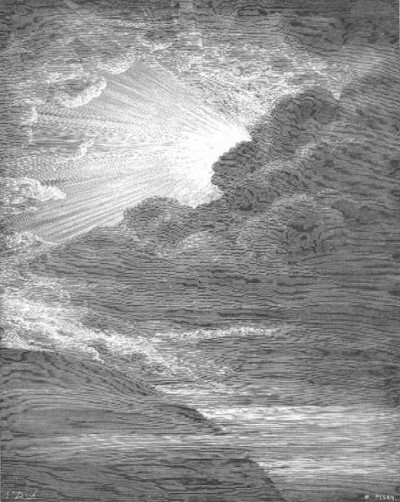The Creation of Light was an illustration by Gustave Doré from 1866 which formed part of his series of drawings for a new publication of The Bible. It would feature different scenes from both the Old and New Testament.
Introduction
La Grande Bible de Tours featured 241 illustrations which had been created by Doré before being handed over to his team of engravers who would handle the transition of these designs into the final published books. The Creation of Light comes directly from Genesis 1:3 in the Old Testament and is one of the earliest illustrations within this publication. The simple, but powerful composition features the sun just starting to appear from behind a dark mass of cloud. The artist would introduce huge amounts of detail into most of his drawings, though in this example there was not much to add, and so we have a fairly straightforward view of the sky, with the symbolic value of this content being much more important. It is unclear whether the illustrations were completed in the same order that they would appear within the book, and it is likely that some ideas would have been rejected as Doré mulled over which scenes from the Bible to include. We do know that he even allowed some of his apprentices to complete drawings on his behalf, but this prominent commission would have been particularly important to him, and so one can imagine that he completed the likes of The Creation of Light entirely on his own.
Genesis 1:3
The Creation of Light - And the Earth was without form and void...
Genesis 1:3
La Grande Bible de Tours
After this illustration, the next in this series would be The Creation of Eve and then Adam and Eve Driven Out of Eden. All of the passages that he focused on would offer emotion and drama, which was entirely suited to the artistic work of Gustave Doré. He was a Romanticist by nature and this approach would spread into the many different mediums in which he was involved, be it illustration, painting or sculpture. Some consider his Bible de Tours drawings to be amongst his biggest achievement and he would require the help of a team of engravers in order to process these designs into the final, printed publication. The printing would be handled by Mame, Tours; Cassell and Co., England after the woodblocks had been engraved and prepared. Doré was happy to concentrate on his illustrations and leave the later stages to others as otherwise he would have been limited in the number of projects that he could accept. By this stage he was popular in the UK and France, with both capital cities offering many new opportunities once his reputation had been established.
The Creation of Light Explained
The rising sun, as shown in this drawing, was there to represent the defeat of the forces of darkness and chaos. God had thought against the rivers and sea in order to prepare the world for the first day of creation. This extraordinary day would feature several times within this artist's series of drawings and it has also provided inspiration to a number of other artists. This interpretation features no figures at all, and provides an uplifting feeling in which a new dawn is promised. One might have imagined the artist producing this piece elsewhere in his career as a painting, where bright tones of colour and contrasts of shading could have been brought in, but he was skillful enough to handle the same topic using the medium of illustration, with variations in his use of lines providing the interest and mood. The Creation of Light remains one of the artist's most famous drawings, because of its prominence within this extraordinary series of works which would actually influence how later generations visually pictured the same Biblical scenes within their own minds.




